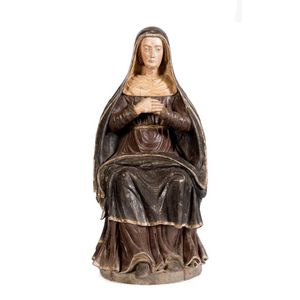Polychrome Carved Walnut Figure of St. Catherine of Siena
You must be a subscriber, and be logged in to view price and dealer details.
Subscribe Now to view actual auction price for this item
When you subscribe, you have the option of setting the currency in which to display prices to $Au, $US, $NZ or Stg.
- Polychrome - Made or finished in many colours. For furniture, it is used to indicated a painted finish.
- Gilding - Gilding is a method of ornamentation whereby a thin sheet of gold metal is applied to items made of wood, leather, ceramics, glass and silver for decorative purposes.
For furniture including mirrors, the sheet of gold is usually applied over a coating of gesso. Gesso is a mixture of plaster of Paris and gypsum mixed with water and then applied to the carved wooden frames of mirrors and picture frames as a base for applying the gold leaf. After numerous coats of gesso have been applied, allowed to dry and then sanded a coat of "bole", a usually red coloured mixture of clay and glue is brushed on and allowed to dry, after which the gold leaf is applied. Over time parts of the gilding will rub off so the base colour can be seen. In water gilding, this was generally a blue colour, while in oil gilding, the under layer was often yellow. In Victorian times, gilders frequently used red as a pigment beneath the gold leaf.
Metal was often gilded by a process known as fire gilding. Gold mixed with mercury was applied and heated, causing the mercury to evaporate, the long-term effect of which was to kill or disable the craftsman or woman from mercury poisoning. The pursuit of beauty has claimed many victims, not the least of which were the artists who made those pieces so highly sought after today.
This item has been included into following indexes:
- religious objects, Christian
Visually similar items

A Chinese carved and tinted bamboo arhat, the arhat hunched back, holding a scroll in his hands, a lion-dog climbing over his right foot, 19.3 cm high

A Chinese carved horn figure of a seated Guan Yin. Height 8 cm

A Chinese carved wooden figure of Guanyin, Ming Dynasty (1368-1644), enhanced with coloured pigment to the front and back, wearing a floriate headdress bearing the prominent carved figure of Amitabha, her hair tied back into a coiled chignon, in a dancerly

A Japanese bronze figure of a Budai monk, 20th century, signed to the base, hardwood stand, 27 x 14.5 cm. Provenance: Collection of Ken Lawrence Foundation
